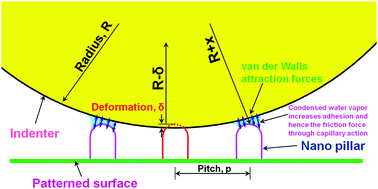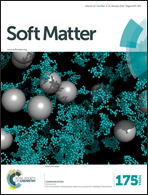Nanotribological and wetting performance of hierarchical patterns†
Abstract
Surface modification is a promising method to solve the tribological problems in microsystems. To modify the surface, we fabricated hierarchical patterns with different pitches of nano-scale features and different surface chemistries. Micro- and nano-patterns with similar geometrical configurations were also fabricated for comparison. The nano-tribological behavior of the patterns was investigated using an atomic force microscope at different relative humidity levels (5% to 80%) and applied normal loads (40 nN to 120 nN) under a constant sliding velocity. The results showed significant enhancement in the de-wetting and tribological performance of the hierarchical patterns compared with those of flat and micro- and nano-patterned surfaces. The PTFE-coated hierarchical patterns showed similar dynamic contact angles (advancing and receding) to those of the real lotus leaf. The influence of relative humidity on adhesion and friction behavior was found to be significant for all the tested surfaces. The tribological performance was improved as the pitch of the nano-scale geometry of the hierarchical pattern increased, even though the wetting property was not influenced significantly. A model was proposed based on the role of intermolecular force to explain the effect of the pitch of the hierarchical patterns on the adhesion and friction behavior. According to the model based on the molecular force, the contact between a ball and the patterned surface was a multi-asperity contact, contrary to the single-asperity contact predicted by the Johnson–Kendall–Roberts (JKR) and Maugis–Dugdale (MD) models. The strong intermolecular forces, which are activated in the confined spaces between the adjacent nano-pillars and the ball, contributed to the contact area and hence the adhesion and friction forces.

- This article is part of the themed collection: Open access articles from Soft Matter

 Please wait while we load your content...
Please wait while we load your content...